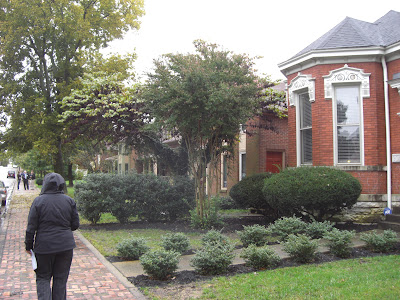I have written before about the Camp White Station Hospital,
in White City, Oregon. It’s a sprawling 145-acre
site that has 50+ buildings constructed in 1942 as part of the US Army’s
training mission in the early days of World War II. Since 1948 the Station Hospital, built of “permanent”
construction, has been owned and operated by the Department of Veterans
Affairs, providing service to former members of the military.
Way back in 1948 the VA was opposed to taking over the
Station Hospital for a variety of reasons but politics (in the form of Wayne
Morse) won the day, and they have operated the facility ever since. In recent years, as the “permanent” buildings
of Camp White became older and ever-less consistent with the VA’s mission of
quality service, the rub between history and function has grown. To its credit, the VA has maintained, and modified,
and upgraded the buildings as it is able, transforming some of these WWII
behemoths (the buildings are HUGE) into state-of-the-art medical service
facilities. But in the past few years,
as demand for veteran’s services grows, the deficiencies of Camp White’s
buildings, no matter how historic, have become a greater obstacle to the VA’s
primary care mission. In 2009 we helped
to create a Manual for Built Resources Blog that identified appropriate strategies for upgrades, but some aspects of the
1942 buildings just can’t be reasonably fixed.
Chief among those is the simple fact that most are made of Structural,
or Hollow Clay Tile. This once popular building method (it was both cheap and fireproof) was something
akin to terra cotta Lego, but without the little interlocking buttons. As you can imagine mortared and stacked blocks,
held together by plaster on the inside and brick veneer on the outside (at
least at Camp White) doesn’t perform particularly well in a seismic event. Fixing that problem is usually accomplished
by building a structural cage inside and then encasing everything in concrete,
chewing up most of the interior space. And
interior space is already at a premium at Camp White as the VA attempts to fit vets into rooms designed more than fifty years ago for short term
occupancy.
The bottom line is that the VA, after considerable thought, is
in the process of removing about 30 historic buildings at Camp White to make
way for new construction that is safe, efficient, and meets the needs of the
population that they serve. And let’s
face it, for most of that population historic preservation is pretty far down
the list of priorities. So, on the one
hand, the loss of a lot of buildings is a pretty sad, if entirely
understandable, turn of events.
But there is good news too.
First, of course, is that the VA will continue to provide quality
services to America’s veterans in southern Oregon. And the VA isn’t removing all of Camp White. Many of the 1942-era structures, including
several of the key properties like the Administration Building (the top photo), will remain in
use, upgraded and modernized as needed under the Manual, for a long time to come.
And the VA has taken the character of its historic site to heart in the
design of the new, replacement, buildings that it will construct after demolition. Many will follow the military designs established
in 1942, right down the pitch of the green asphalt roof and the brick
veneer. Check out the two buildings
below…one is historic (and scheduled for removal and replacement) and the other was built last
year. Care to guess which is which? And, if you have ever been to the “Dom,”
(okay, Southern Oregon Rehabilitation Center & Clinics) you know about the
two-story hallways that connect almost the entire campus. The hallways, whether original or rebuilt,
will remain a part of the campus too.
I think if a solider that trained at Camp White, and had
occasion to visit the Station Hospital during WWII, were to return for a visit
in a few years when this is all completed, he’d feel right at home. And the VA, for its part, will likely make
sure through its continued support of the Camp White Historical Society, and
maybe some interpretative signage, that others can also appreciate what’s so significant
about the “The City in the Agate Desert” too.






